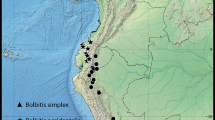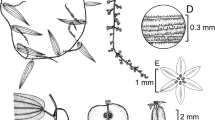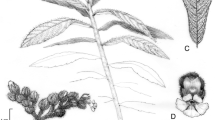Abstract
Three new species ofDasylirion and a new variety ofD. longissimum Lem. from the mountains of northern Mexico are described and illustrated. Two of the new species are from northwestern Mexico:D. gentryi, with large, rosecolored fruits and glossy, non-waxy leaves; andD. sereke, characterized by roundish fruits with an unusuall large style.Dasylirion miquihuanense is a new species from northeastern Mexico with narrow, strictly upright leaves and widely separated marginal prickles. TheDasylirion longissimum complex consists of two species,D. quadrangulatum S. Wats andD. longissimum Lem., characterized by narrow, quadrangulate leaves with reduced or absents marginal prickles. Distinguishing features of these two species, which have often been confused, are presented andD. longissimum var.treleasei, characterized by small flowers and fruits, is described.
Similar content being viewed by others

Literature Cited
Bogler, D. J. 1994. Taxonomy and phylogeny ofDasylirion (Nolinaceae). Ph.D. dissertation, University of Texas at Austin.
— 1995. Systematic ofDasylirion: taxonomy and molecular phylogeny. Bol. Soc. Bot. México 56: 69–76.
— &B. B. Simpson 1995. A chloroplast DNA study of the Agavaceae. Syst. Bot. 20: 191–205.
——. 1996. Phylogeny of Agavaceae based on ITS rDNA sequence variation. Amer. J. Bot. 83: 1225–1235.
Cronquist, A. 1981. An integrated system of classification of flowering plants. Columbia University Press, New York.
Cunningham, I. S. 1994. Howard Scott Gentry. Econ. Bot. 48: 359–381.
Dahlgren, R. M., H. T. Clifford &P. F. Yeo. 1985. The families of the monocotyledons. Springer-Verlag, Berlin.
Gentry, H. S. 1942. Rio Mayo plants: a study of the flora and vegetation of the valley of the Rio Mayo, Sonora. Carnegie Inst. Wash. Publ. 527, Washington DC.
— 1982. Agaves of continental North America. University of Arizona Press, Tucson.
Hooker, J. D. 1900.Dasylirion quadrangulatum. Curtis Bot. Mag. 56: pl. 7749.
Laracine, C., J. Favre-Bonvin &P. Lebreton. 1982. 3-O methyl, 8-C-methyl-quercetin, ein neues flavonoid aglycone ausDasylirion acrotrichum undXanthorrhoea hastilis (Liliales). Zeits. Naturf. 37c: 335–336.
Lemaire, C. A. 1856. Miscellanées. Ill. Hort. 3: 91.
McVaugh, R., 1956. Edward Palmer. University of Oklahoma Press. Norman.
Pennington, C. W. 1963. The Tarahumara of Mexico, their environment and material culture. University of Utah Press, Salt Lake City.
Stafleu, F. A. & R. S. Cowan. 1979. Taxonomic literature. Vol. 2: H-Le. Regnum Veg. 98.
Standley, P. C. 1920–1926. Trees and shrubs of Mexico. Contr. U.S. Natl. Herb. 23: 1–1721.
Trelease, W. 1911. The desert group Nolineae. Proc. Amer. Phil. Soc. 50: 404–442.
Watson, S. 1879. Revision of the North American Liliaceae. Proc. Amer. Acad. Arts 14: 213–289.
Author information
Authors and Affiliations
Rights and permissions
About this article
Cite this article
Bogler, D.J. Three new species of Dasylirion (Nolinaceae) from Mexico and a clarification of the D. longissimum complex. Brittonia 50, 71–86 (1998). https://doi.org/10.2307/2807720
Issue Date:
DOI: https://doi.org/10.2307/2807720



